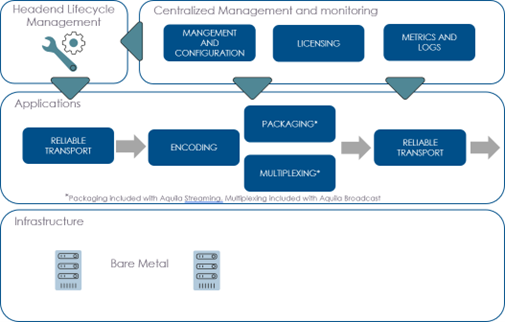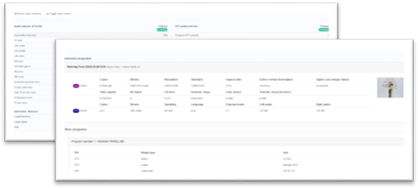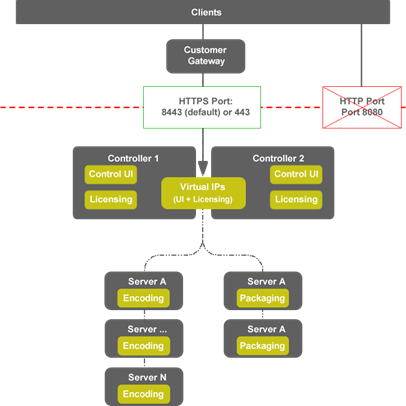MK.IO Beam Streaming & Broadcast
MK.IO Beam Streaming and MK.IO Beam Broadcast assemble multiple video processing components to offer end to end media processing and delivery. Each component provides a part of the processing chain.
Components
Layers
The solution has three main layers:
- The management layer: Addresses configuration and control, deployment/orchestration of the applications, entitlement licensing and monitoring of the headend in a centralized way.
- The processing layer: Processing applications (encoding, packaging, multiplexing).
- The infrastructure layer: Solution can be deployed in an IT datacenter.
These three layers are glued together by the common micro-services architecture of all the MediaKind components. Each layer comprises multiple components as described below.

MK.IO Beam Streaming and MK.IO Beam Broadcast use components to address the different processing listed below:
- Management and configuration.
- Live video service encoding.
- Live radio service encoding.
- Live video service packaging (MK.IO Beam Streaming only)
- Live video service multiplexing (MK.IO Beam Broadcast only)
- Reliable Transport
Management Layer
The management layer is the control/command of the whole headend. This is the single-entry point to access all functions of the headend. This interface (UI & API) is designed to:
- Deploy all the applications on the nodes which are part of the system.
- Configure the different services and store the configuration data.
- Control services (start, stop, failover, server assignation).
- Aggregate the logs and metrics from all nodes and applications.
- Provide licenses to all applications. To provide all these features, the management layer includes the controller, the deployment toolkit, and the licensing servers. To avoid any impact in case of fault in the management layer, it is designed to be high availability. The recommendation is to deploy three instances of this management node to replicate the critical component and avoid any downtime.
Configuration, Control and Monitoring
MK.IO Beam Streaming and MK.IO Beam Broadcast benefit from a single entry-point for all operations. MediaKind management and configuration component is the centralized point to configure and command the headend.
It is built upon the following principles:
- Centralized configuration, control and monitoring for MediaKind SW components that provides an immediate overview of an entire head-end system.
- A service driven approach for configuration, control and monitoring providing an optimized granularity compared to device level.
- A flexible service allocation: selection of the resource, combined with a floating licensing model.
- A solution that allows production teams to leverage preparation activities in the lab, and during pre-production using template mechanisms.
- A micro-services design matching different deployment patterns, from a single stand-alone node to a distributed and redundant configuration.
- A Web UI applicable for all supported products, with embedded help solutions aiming at reducing training investment. Note: Access via REST API is also provided to offer network integration capabilities.
The management nodes gather all the metrics and logs from the full headend to provide a global health of the system. This monitoring layer provides information on the deployed applications and the infrastructure the headend is running on.
License Management
The system works with a centralized license server that holds all the rights required to run the headend. Rights are captured upon service start. They are released when service is stopped.

It is recommended to have the license server running in 1+1. The recommended deployment is to have the license servers running on their own nodes so they can address multiple deployments. In case of a single deployment then it is possible to co-locate the license servers with the management servers.
Processing Layer
The processing layer comprises one or multiple components running on any infrastructure. To increase reliability, this layer is designed to be completely independent of the management layer. This independence ensures continuous processing even if the connection with the management layer is lost.
Live Video Service Encoding
MediaKind brings together 25 years of video compression experience to deliver the highest quality, any screen software applications for live video encoding and transcoding. MediaKind's continued investment and focus on the latest compression technologies ensures that the encoding component will efficiently deliver the best picture quality over bandwidth in all encoding environments and networks. This component is ideal for any real-time broadcast application, including IPTV, cable, DTH and Internet TV. As a service-oriented software solution designed to address today’s key technological and operational challenges:
- Use one software headend for all video applications: DTH/Satellite, IPTV, Cable and Multiscreen.
- Provide the highest video quality by leveraging the latest compression standards (MPEG-2, MPEG-4 AVC & HEVC).
- Optimize OPEX and CAPEX going to full IP and leverage the latest IT technologies to reduce infrastructure and maintenance costs.
- Reduce operational complexity with a service oriented centralized UI (Single point of entry).
- Deploy with confidence by leveraging guaranteed performances and redundancy schemes.
Live Video Service Packaging
The packaging component is a powerful solution designed for the distribution, personalization, and monetization of multiscreen video services. You can also deploy it across your network to drastically reduce the bandwidth, storage or equipment footprint usually required to distribute video services securely to smartphones, tablets, connected TVs, game consoles, PCs, or OTT Set- Top-Boxes. MediaKind architecture is extremely modular and can scale according to your needs. It combines the following key functions:
- Stream ingest with efficient buffer and storage management.
- Just in Time Packaging (JITP) and encryption with a wide variety of formats and DRMs.
- Highly scalable origin server.
Reliable Transport (SRT, Zixi, RIST)
Another complexity for broadcast operations is how to send or retrieve the content to/from a headend via private or public IP networks The integration of SRT, RIST, and Zixi as a component of the MK.IO Beam Streaming and MK.IO Beam Broadcast solutions allows an easy to setup, and secure link for reliably passing data.
Solution Monitoring
To guarantee the optimal behavior of the solution, monitoring tools are deployed along with the processing applications. These comes in different modules.
Product Statistics and Monitoring
The solution comes with built-in short-term monitoring that provides a first level of health information. All processing components send statistics of their input and output. The statistics for each service are centralized on the Controller.

Each service can be monitored through the Controller UI or information can be gathered from the API.
Controller North Bound Interface
The Controller provides a north bound interface for integration with any system already in place. This can be done through the RESTful API but also using SNMP trap forwarding. This allows having all alarms for the headend in a central place.
Security
Access & Security Configuration
Controller is the single-entry point for any action via the UI or the API. A virtual IP is defined to always redirect the requests to the active controller when the solution is deployed in 1+1 redundancy.

It is possible and recommended to activate the HTTPS connection and to use the API in a secured way to secure the access to the system. By default the user management is activated to access the UI.
OS Security
All the products are software products running on Linux operating systems. To ensure the security of the solution MediaKind uses Nessus® vulnerability scanner tool to highlight any security risk. Based on the results, MediaKind regularly (every two months) propose “security packages” to secure the OS the MediaKind products are running on. Each security package will upgrade some of the libraries present on the OS to ensure products are using the secured version of these. Products are tested with these security packages installed to ensure their behavior with the latest libraries. OS should not be upgraded outside of these security packages.